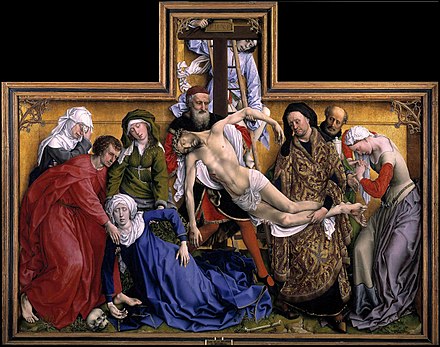From the Office of Mattins for Holy Saturday
Reading 4
From the Treatise of St. Augustine, Bishop of Hippo, Upon the Psalms
On Psalm lxiii, 7
We shall attain to thoughts that are very deep: but God shall still be exalted. The enemies of our Lord had communed of laying snares privily; they had said, Who shall see them? They had searched out iniquities; they had accomplished a diligent search. And Man attained even unto (the realization of) their counsels, for the Lord, as Man, suffered Himself to be taken. For He had not been taken at all, unless He had been a Man, or seen, unless He had been a Man, or smitten, unless He had been a Man, or crucified, unless He had been a Man, or have died, unless He had been a Man. Man therefore, He attained unto all those sufferings, which had had nothing in Him, unless He had been a Man. But if He had not been Man, man had not been redeemed. And the Lord as Man attained to thoughts that were very deep, yea, secret; showing the Manhood to the eyes of men, and keeping the Godhead within Him; veiling the form of God, as touching Which, He is Equal to the Father, and manifesting the form of a servant, as touching which, He is inferior to the Father.
R. Our Shepherd, even the Fountain of living waters, is gone from us; He passed away, and the sun was darkened.
* For now hath our Saviour bound him captive, which bound the first man captive; this day hath He burst the gates and bars of death.
V. The bands of hell He hath utterly abolished, and hath done away the power of the devil.
R. For now hath our Saviour bound him captive, which bound the first man captive; this day hath He burst the gates and bars of death.
From the Treatise of St. Augustine, Bishop of Hippo, Upon the Psalms
On Psalm lxiii, 7
We shall attain to thoughts that are very deep: but God shall still be exalted. The enemies of our Lord had communed of laying snares privily; they had said, Who shall see them? They had searched out iniquities; they had accomplished a diligent search. And Man attained even unto (the realization of) their counsels, for the Lord, as Man, suffered Himself to be taken. For He had not been taken at all, unless He had been a Man, or seen, unless He had been a Man, or smitten, unless He had been a Man, or crucified, unless He had been a Man, or have died, unless He had been a Man. Man therefore, He attained unto all those sufferings, which had had nothing in Him, unless He had been a Man. But if He had not been Man, man had not been redeemed. And the Lord as Man attained to thoughts that were very deep, yea, secret; showing the Manhood to the eyes of men, and keeping the Godhead within Him; veiling the form of God, as touching Which, He is Equal to the Father, and manifesting the form of a servant, as touching which, He is inferior to the Father.
R. Our Shepherd, even the Fountain of living waters, is gone from us; He passed away, and the sun was darkened.
* For now hath our Saviour bound him captive, which bound the first man captive; this day hath He burst the gates and bars of death.
V. The bands of hell He hath utterly abolished, and hath done away the power of the devil.
R. For now hath our Saviour bound him captive, which bound the first man captive; this day hath He burst the gates and bars of death.
From Divinum Officium
The physicality of Christ’s Redemption of Mankind which St Augustine wrote of in the early fifth century can be seen in many depictions of the Lord’s death but few capture it as powerfully as Rogier van der Weyden was to do just over a millennium later in The Descent from the Cross painted about 1435 for an archers guild in Louvain ( Leeven ), and now in the Prado in Madrid. It not just the depiction of the limp dead body of Christ that speaks of real physical pain and suffering but also the actions and attitudes of the figures around, and all presented with an attention to flesh and blood, to cloth and wood and iron and thorns that makes it immediate and compelling.

The Descent from the Cross
Image: Wikipedia
This proved to be one of the most influential paintings of its age, and its combination of technical skill and human compassion with spiritual insight make it one of the glories of Netherlandish art of that or any other time.
There is an online detailed study of the painting from Wikipedia at The Descent from the Cross (van der Weyden) and from the Prado website at The Descent from the Cross
There are two other insightful accounts at Descent From the Cross (Deposition), Roger Van der Weyden: Interpretation, Analysis and at Rogier van der Weyden through 'The Descent from the Cross'


No comments:
Post a Comment